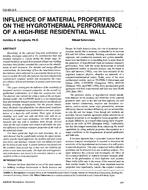
CH-95-03-5 — Influence of Material Properties on the Hygrothermal Performance of a High-Rise Residential Wall
Investigates the influence of the variability of measured moisture transport properties on the overall hygrothermal performance of a high-rise construction wall. The analysis was carried out using a state-of-the-art hygrothermal model. The LATENITE model is a two-dimensional heat and moisture transport program tailored specifically for building envelope investigations. For the present simulations, the model was adapted for one-dimensional conditions and hourly simulations were predicted for a one-year performance of a high-rise wall section. Three types of facade cladding were used, two with red brick (one with an extremely high water vapour permeance, one with normal permeance) and one with a sandlime stone facade, Several cases for the wall systems were tested to determine the relative influence of moisture transport properties of the wall on the predicted results. For these particular high-rise wall structures, the results showed that by significantly varying the vapour permeability and the liquid diffusivity, the monthly and year-round heat flows and moisture contents were not influenced much for the brick facade walls. A similar behaviour was found with the sandlime stone facade but, in this case, the exhibited differences were more noticeable. The high-rise wall hygrothermal performance was found to be extremely sensitive to the sorption isotherm material property.
KEYWORDS: year 1995, properties, materials, performance, multistorey buildings, domestic, walls, moisture, computer programs, heat flow, calculating, bricks, water permeance, testing, content, sorption properties, facades, relative humidity, measuring, temperature.
Citation: Symposium, ASHRAE Trans. 1995, Vol.101, Part 1, Paper number CH-95-1-1, 525-527
Product Details
- Published:
- 1995
- File Size:
- 1 file , 790 KB
- Product Code(s):
- D-16770


